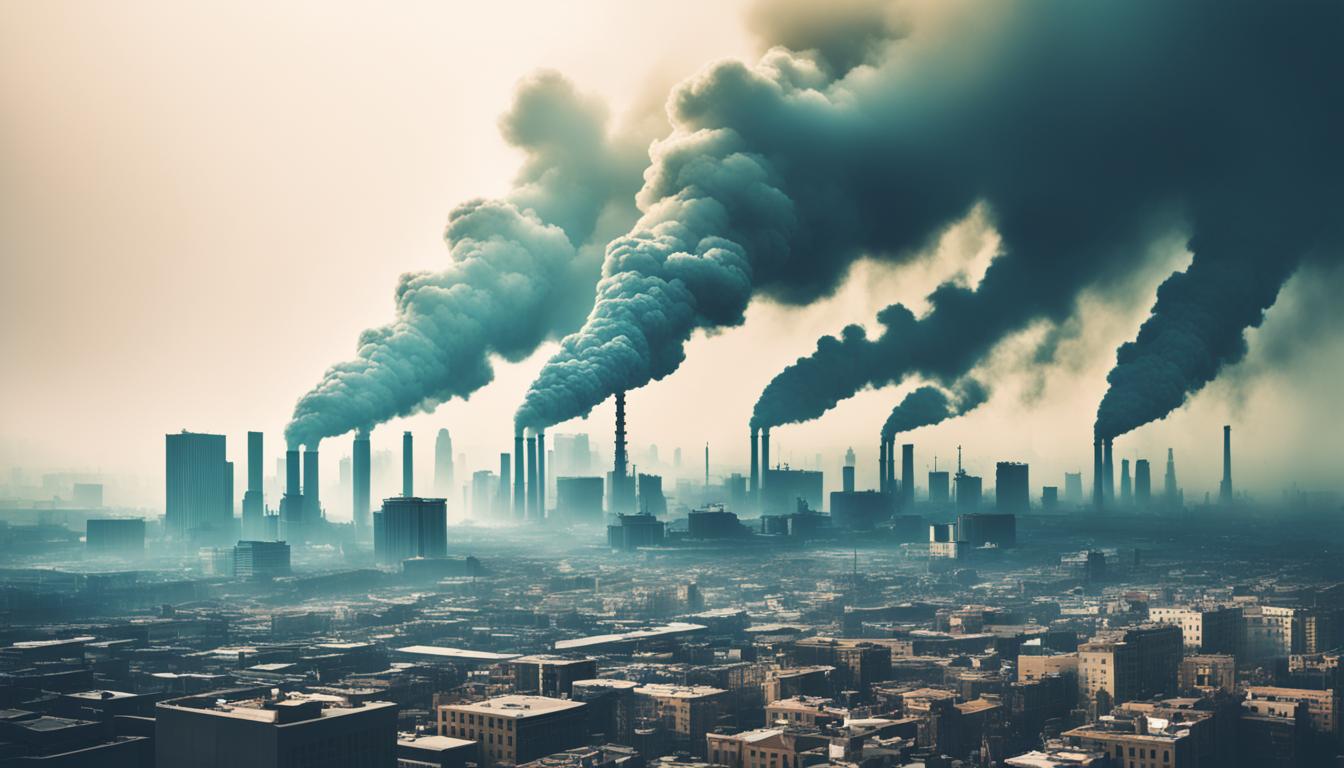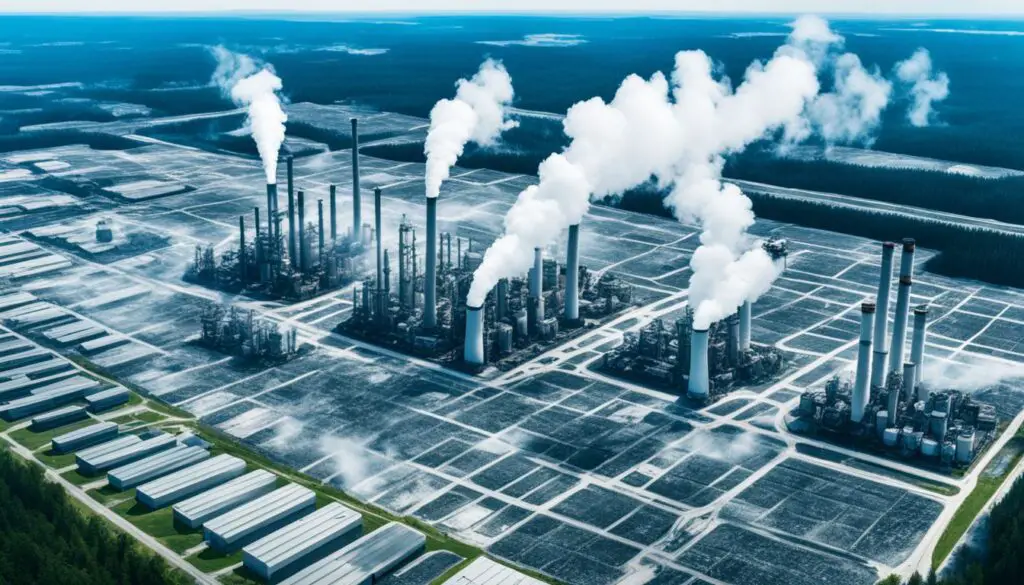
AI technology is revolutionizing how we fight pollution. It presents new ways to tackle our biggest environmental problems. With growing worries about pollution’s effects on Earth, AI has become a key player.
OpenAI says AI and computing significantly impact carbon emissions. It’s vital to use AI for saving our environment. The International Energy Agency points out that data centers and networks also emit carbon, adding to our planet’s issues.
The World Economic Forum warns us about e-waste. They say we’ll soon have more e-waste than the Great Wall of China in weight. This fact shows we must find sustainable ways to handle our increasing pollution problems.
Despite AI’s own carbon footprint concerns, some startups are making strides with it. They use AI to directly address pollution. These companies craft new solutions to clean different sectors.
For example, Refiberd uses AI for a recycling system that sorts textiles well, cutting down waste. Mortar IO applies AI for planning how to make buildings emit less carbon, focusing on updates to old buildings. AgroScout helps farmers use AI to grow crops more sustainably.
Eugenie.ai works with industries like metal, mining, and oil and gas. They offer AI software to help these industries pollute less. This shows just a glimpse of AI’s role in fighting pollution.
As AI tech gets better, we’ll see more innovative solutions for a greener future. The fight against pollution with AI is just starting, and it holds great promise for our planet.
Key Takeaways:
- AI technology is being utilized to combat pollution and provide innovative solutions to environmental challenges.
- Data centers and data transmission networks contribute to carbon emissions, emphasizing the importance of sustainable AI development.
- E-waste has become a major concern, urging the need for sustainable practices to address this growing problem.
- Startups are leveraging AI to address pollution-related issues in sectors such as textiles, buildings, agriculture, and manufacturing.
- The potential of AI technology in combatting pollution is vast and holds promise for a cleaner, more sustainable future.
Startups Using AI to Address Pollution
Startups lead the fight against pollution and climate change with AI. They use AI to tackle issues like carbon emissions, textile waste, and sustainable farming. This innovative approach helps the environment.
Refiberd: Revolutionizing Textile Waste Management
Refiberd in California is changing the textile industry with AI and robotics. Their system sorts textiles to reduce waste. It uses machine learning to separate fabrics efficiently and helps combat fashion industry pollution.
Mortar IO: Transforming Building Retrofits
Mortar IO in London uses AI to make buildings greener. They focus on improving energy efficiency in old buildings. Their AI tools find the best ways to retrofit buildings, saving energy and helping the environment.
AgroScout: Revolutionizing Sustainable Agriculture
AgroScout in Israel pushes for sustainable farming with AI. Their platform offers real-time crop data to farmers. It reduces the need for chemicals and promotes efficient farming, making agriculture more sustainable.
Eugenie.ai: Driving Emission Reduction in Manufacturing
Reducing emissions in heavy industries is tough. Eugenie.ai uses AI to help manufacturers lower emissions. Their technology gives insights on reducing emissions, making industries greener.
These startups are just a few examples of AI fighting pollution and climate change. They show the power of AI in creating a sustainable future.

AI Technology and Air Pollution in Uganda
Engineer Bainomugisha and his team at Makerere University are tackling air pollution with AI. Their project, called AirQo, collects data to understand and fight pollution. It helps make decisions that improve air quality.
AirQo places sensors on buildings and motorbike taxis to track air pollution. These sensors, spread throughout the city, offer real insights into where air is dirtiest. AI technologies then analyze this data, predicting where air might get worse.
Having this info, people and leaders can act to protect health and the planet. Knowing where air pollution hits hardest encourages smart choices. Leaders can craft policies to clean the air.
Google’s AI Impact Challenge supports AirQo, helping it grow across Uganda. This backing boosts data collection and project spread. It recognizes AirQo’s contribution against environmental challenges.
By using AI, Uganda could see cleaner air and healthier lives. This tech empowers communities to fight pollution proactively. It marks a step toward better air for us and future generations.
Key Takeaways:
- Engineer Bainomugisha’s team uses AI to address Uganda’s air pollution.
- The AirQo project’s sensors on buildings and taxis monitor pollution in real-time.
- AI analysis of data aids in predicting and managing pollution.
- Support from the Google AI Impact Challenge helps expand AirQo’s reach.
- The project showcases the power of AI in improving air quality and tackling pollution.

Conclusion
AI technology brings new ways to fight pollution and help the environment. Companies are using AI to solve pollution problems. This includes managing textile waste and reducing carbon emissions.
The AirQo project in Uganda shows how AI can track and fight air pollution. It’s a great example of AI’s potential.
Yes, AI’s own carbon footprint is worrying. But steps are taken to lessen its effect and make AI greener. By using clean energy and improving algorithms, we can make AI more environment-friendly.
Hardware is also getting better, using less energy. Data centers are becoming more sustainable. These changes help.
AI has a big role in creating a cleaner future. With smarter AI, we can find new ways to protect our environment. It’s about making a better world for everyone.
FAQ
How is AI technology being used to combat pollution?
What are some startups using AI to address pollution?
How is AI technology being used to address air pollution in Uganda?
Source Links
- https://sloanreview.mit.edu/article/tackling-ais-climate-change-problem/
- https://blog.google/outreach-initiatives/entrepreneurs/how-4-startups-are-using-ai-to-solve-climate-change-challenges/
- https://about.google/stories/clean-air-for-kampala/






